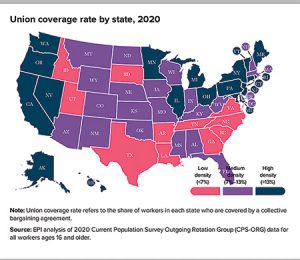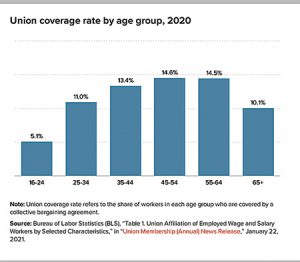Who are today’s union workers?
Unionized workers are diverse, and they work in most industries across America

 One in nine workers — 15.9 million working women and men in the United States — are represented by a union. This makes Organized Labor one of the largest institutions in America.
One in nine workers — 15.9 million working women and men in the United States — are represented by a union. This makes Organized Labor one of the largest institutions in America.
It is also one of the most diverse, representing workers of all ages, at all levels of education, of diverse races and ethnicities, and across most industries in America. According to an analysis of 2020 statistics compiled by the Economic Policy Institute (EPI), about two-thirds of working people ages 16 and older who are covered by a union contract are women and/or people of color.
- As of 2020, roughly 10.6 million of the 15.9 million workers covered by a union contract are women and/or people of color.
- Almost half of workers represented by a union are women (47.1 percent).
- Nearly four in 10 (37.4 percent) are African American, Hispanic, Asian Americans and Pacific Islanders (AAPI), or other nonwhite workers.
- Black workers are the most likely to be represented by unions: 13.6 percent are covered by a collective bargaining agreement, compared with 12.3 percent of white workers, 11.0 percent of Hispanic workers, and 10.3 percent of AAPI workers.
SECTORS
Union workers hail from a variety of sectors, but the biggest share work in education or health services.
- Nearly three in 10 private-sector workers (27.2 percent) covered by a union contract work in education or health services.
- Nearly half of workers (49.7 percent) covered by a union contract are public-sector workers.
- Roughly one in seven workers (15.1 percent) covered by a union contract works in transportation or utilities.
- Nearly one in six private-sector workers (16.0 percent) covered by a union contract work in manufacturing.
EDUCATION
Unions represent workers at all levels of education.
- Roughly three in 10 workers (30.3 percent) ages 16+ and covered by a union contract have a high school or less education.
- Nearly six in 10 workers (58.4 percent) covered by a union contract have an associate degree or more education.
- Close to half (46.5 percent) have a bachelor’s degree or more education.



2 Comments
Unions are the only institution whose purpose is to bring meaningful democracy to the nation’s workplaces. Everyday wage earners use that democracy to gain a collective say in determining their future quality of life.
That last point is similar to the actions of our nation’s founders when they collectively worked to end the ability of England’s landed aristocracy dictating the political economy of “her colonies.” Which makes unions as American as apple pie.
Moreover, unions are arguably our nation’s oldest, largest, and most successful institution advocating for economic and social justice.
John Kretzschmar, you have put in words a very good example of the way to picture the most important means of how the cause of using a union membership effects not just an individual’s life but also the country’s
too!